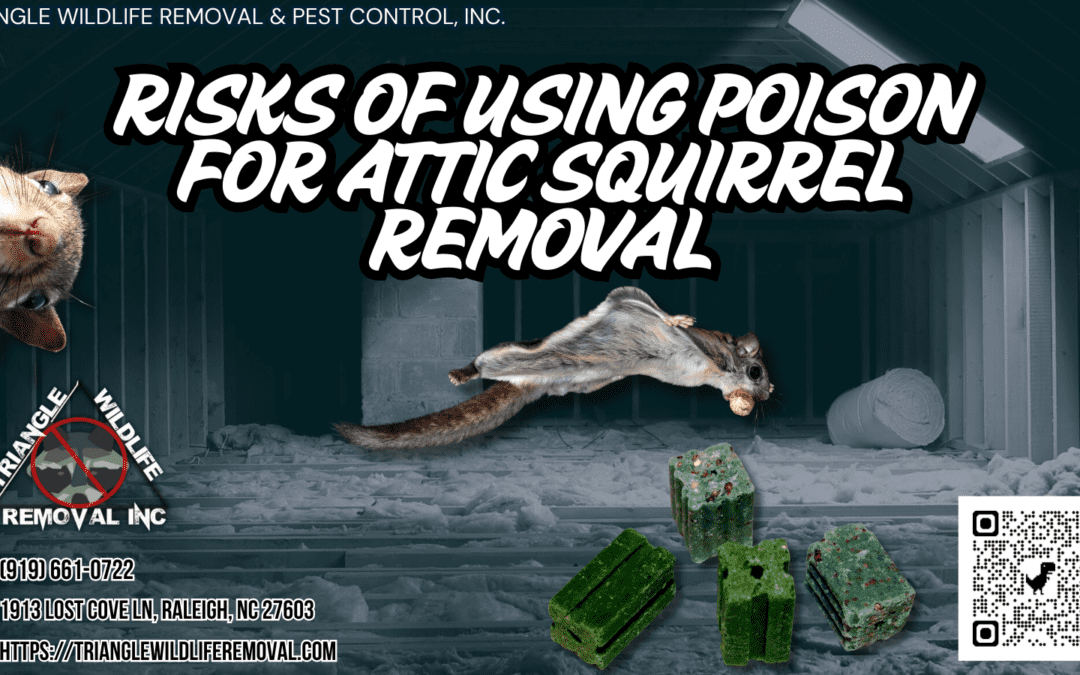When considering methods for attic squirrel removal, using poison may seem like a quick solution. However, the risks associated with this approach are significant. From unintended harm to other wildlife to the possibility of environmental contamination, the implications go beyond just eliminating the target pests. Additionally, there are concerns regarding the health and safety of both pets and humans. Before resorting to such drastic measures, it is essential to weigh the potential consequences carefully.
Key Takeaways
- Poison risks harming non-target wildlife and disrupting ecosystems.
- Health hazards for pets and humans extend beyond environmental concerns.
- Legal implications and ineffectiveness make poison a risky squirrel removal method.
- Safer alternatives like live traps prioritize wildlife protection and minimize environmental impact.
Toxicity to Non-Target Wildlife
Using poison for attic squirrel removal poses a significant risk of toxicity to non-target wildlife in the surrounding area. When poison is used, there is a high chance that other animals, such as birds, pets, or even beneficial insects, may consume the poison either directly or by feeding on poisoned squirrels. This can lead to unintended harm to these animals and disrupt the natural balance of the ecosystem.
To mitigate the risks of toxicity to non-target wildlife, it is essential to consider potential alternatives to poison for attic squirrel removal. One effective alternative is the use of live traps, which safely capture squirrels without causing harm. Once captured, the squirrels can then be relocated to a more suitable habitat away from human dwellings.
Considering the long-term consequences of using poison, the impact on non-target wildlife can be devastating and have far-reaching effects on the environment. Therefore, opting for safer removal methods is crucial to prevent harm to wildlife and maintain ecological balance in the area.
Risk of Secondary Poisoning
The use of poison for attic squirrel removal not only poses a risk of toxicity to non-target wildlife but also introduces the potential for secondary poisoning in the ecosystem. When poison is used to eliminate squirrels in attics, there is a high likelihood that these squirrels may consume the poison and then be preyed upon by other animals. This can lead to secondary poisoning as the toxin moves up the food chain, affecting predators and scavengers.
The risk of secondary poisoning is a significant concern for wildlife conservation and can have far-reaching ecosystem impacts. Predators such as owls, hawks, or foxes that feed on poisoned squirrels can suffer adverse effects, including sickness and death. This disruption in the predator-prey balance can have cascading effects on the entire ecosystem, potentially leading to imbalances in population dynamics and biodiversity.
Therefore, when considering attic squirrel removal methods, it is crucial to prioritize options that minimize the risk of secondary poisoning to safeguard wildlife conservation and prevent negative ecosystem impacts.
Environmental Contamination Concerns
Environmental contamination concerns arise when toxic substances from the use of poison for attic squirrel removal infiltrate soil, water, and vegetation, posing risks to ecosystems and potentially impacting human health. Soil pollution can occur when the poison seeps into the ground, affecting soil quality and harming beneficial organisms. This pollution can disrupt the balance of nutrients and microorganisms essential for plant growth, leading to long-term damage to the ecosystem.
Water contamination is another significant issue that can result from using poison in attics. Rainwater can wash the toxins into nearby water sources, contaminating streams, rivers, and groundwater. This contamination not only affects aquatic life but can also potentially enter the drinking water supply, posing a risk to human health.
Health Hazards for Pets and Humans
Concerns regarding the health hazards posed to pets and humans arise when poison is used for attic squirrel removal, extending beyond environmental contamination risks. The use of poison in attic squirrel removal can lead to significant health risks for both pets and humans. Allergy risks and respiratory issues are common consequences of exposure to toxic substances used to eliminate squirrels. Pets, especially dogs and cats, are particularly vulnerable to these health issues as they may come into direct contact with the poison or ingest it accidentally. Moreover, neurological effects and skin irritation are also potential dangers associated with the use of poison in enclosed spaces like attics. Humans exposed to these chemicals may experience symptoms ranging from mild skin irritation to more severe neurological effects. It is crucial for individuals considering attic squirrel removal to prioritize the health and safety of both pets and humans by opting for safer and more humane removal methods.
Ineffectiveness and Potential Legal Issues
Given the potential drawbacks associated with using poison for attic squirrel removal, what are the key considerations regarding its effectiveness and the legal implications involved? When it comes to dealing with attic squirrels, using poison may pose significant ineffectiveness risks and potential legal ramifications.
- Ineffectiveness: Poison may not always eliminate squirrels effectively, leading to prolonged infestations and continued damage to the attic.
- Harm to Non-Target Animals: Poison baits can harm unintended wildlife or pets that consume them, causing further ecological imbalances.
- Legal Concerns: The use of poison for wildlife control may be regulated by laws and may require specific permits to avoid legal repercussions.
- Residual Effects: Poison residues left in the attic can pose risks to future residents, especially children or pets, long after the squirrel issue has been addressed.
Considering these factors, it becomes evident that poison may not only be an ineffective solution for attic squirrel removal but also bring about potential legal troubles, making it a less favorable option.

